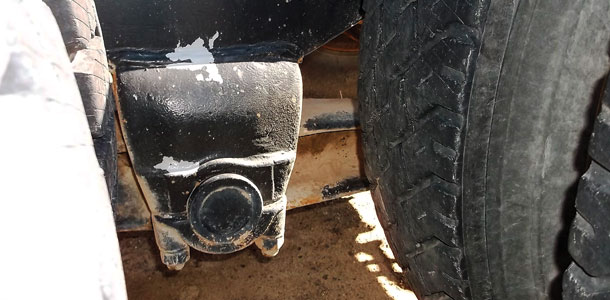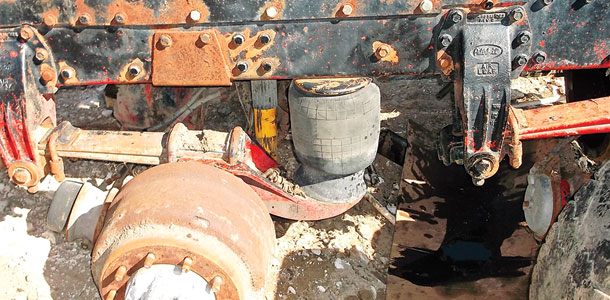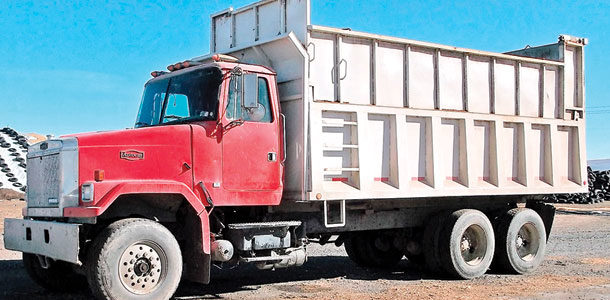There is a lot of material to move around on a dairy farm, from feed coming in at harvest to feed and bedding delivered to the end user (the cows) to the removal and spreading of manure – and it all needs wheels under it to move. As the size of a “normal” dairy has increased, more and more dairies need their own fleet of farm trucks.
Historically, the gasoline-powered two-ton truck has been the workhorse of the farm. These were simple to operate and repair, as the engine and brakes, etc., were similar to those of a passenger vehicle or pickup truck. These similarities made the maintenance and repair of the farm truck simple since the components were just like those on the family car, just bigger.
As farm sizes grew, so did the need for larger trucks. As the size of the trucks grew, the mechanicals of the trucks grew and became different from those of the common automobile. Consider the brakes: On lighter-duty trucks, hydraulic brakes work just fine.
As trucks increase in size, a more robust braking system is needed, and that system usually is air brakes. This adds complexity and requires a learning curve for the owners, operators and maintenance people involved. Until diesel engines became the norm for farm tractors, diesel-powered farm trucks were seen as another new threat to operation and maintenance skills.
Soon it was discovered that a retired line-haul diesel-powered truck would outperform a new gasoline-powered truck of the same size and would be much less expensive to operate. With this came a learning curve.
Highway trucks are designed to be as light as possible so more cargo can be carried with each load. Highway trucks are restricted as to how much weight may be carried on each axle and how much total weight for the whole combination.
When a truck comes from the factory with the rear tandem axles rated at 34,000 pounds, which is the legal maximum in most places, that truck will do very well operating at that weight for a million miles or so.
When that truck is retired and purchased by a dairy farm, and a spreader box installed, and no weigh stations to enforce the weights are involved, a good soggy load of manure may put 50,000 pounds on those axles and suspension. The dangers of mechanical failure are secondary to the suspension and axles not being able to be stable under that kind of overload.

One of my friends told of a feedlot mounting a feed mixer and feeder box on a new truck. It was grossly overloaded, and in its second month of operation, rolled onto its side. The twisted frame and rear axles were replaced from the cab back with the frame and axles from a retired ready-mix concrete truck.
When you see a concrete truck on the highway, most will have one to four air-lift axles that keep the truck at the legal weight limit for each axle while traveling on the highway but are lifted up when the truck gets to the job site, so it can maneuver without tearing up the extra axles.
That means that the steering axle and tires and the drive axles, tires and suspension must be able to handle the total weight of the mixer and concrete on the rough terrain of a job site. This means that the trucks are factory-engineered for the tandem drive axles to support weights over 50,000 pounds on rough terrain.
This is what is desired for the axles of a farm mixer/feeder, silage or spreader truck. The odds are that you will eventually have an employee or relative load a silage truck full of gravel. The suspension and axles from a retired ready-mix truck will probably survive such abuse.
The current generation of trucks coming off the road after a line-haul career will probably have some form of airbag rear suspension. These are lightweight and add a soft ride to the vehicle. They are also rated to handle 34,000 to 40,000 pounds. Most are not suitable for heavy off-road use.
The current generation of retired ready-mix trucks will have some form of walking-beam rear suspension. This is simple, strong and allows for excellent articulation, which helps the truck maintain traction by all the drive wheels.
Some of these suspensions have a single massive spring-pack on each side of the truck. The more common system will attach to the frame either directly or via big rubber cushion pads. Any of these will be inherently stable and resist leaning to one side if the load is not balanced.
Callahan Manufacturing, in Royal City, Washington, has made and marketed a fifth-wheel hoist for decades. This will lift the front of a 40-foot trailer high enough to dump its load. Occasionally these are mounted on a new truck, but most end up on an older truck.
Dean Callahan said that a soft-riding highway suspension is not suitable for these hoists, that even with the stabilizing out-riggers, a solid suspension is needed. As the Callahan family expanded into the dairy business, the same styles of heavy suspension trucks were used there.

The concrete mixer portion of a ready-mix truck is generally what wears out first. There are many advantages to using these for farm trucks. One is that they come with a low enough first gear so they can function at slow speeds when feeding cattle at a feedbunk or when following a corn or haylage chopper in the field at harvest.
Another advantage is that they come with a very robust hydraulic system, easily capable of powering a feed mixer/feeder or a spreader. These are driven from the engine crankshaft so there is no PTO drive to deal with.
The massive plus is the cost. Callahan said that in central Washington state he can source a truck and remove the concrete mixer and extra axles and have a truck ready to accept a bed or feeder box for around $15,000. Prices for comparable new trucks are near $100,000. Sources for these retired units are heavy equipment auctions and used equipment dealers who frequent those auctions.
Callahan noted that these units usually have low miles but high engine hours. Most, he noted, will run for years in seasonal farm service with only regular maintenance.
Larger operations should have maintenance shops on-site capable of removing original equipment, then adding the worn-out mixer unit to an established scrap yard. It may take some research, but manufacturing facilities capable of this work should be available in all regions. PD
Brad Nelson is certified by Carlisle Motion Control Industries Inc. in brake maintenance and is a trucking consultant, with more than 30 years experience in the trucking industry.
PHOTOS
TOP: This is a retired ready-mix truck. The ready-mix unit and extra axles were removed and a silage bed installed. Note the over-sized front axle and tires. Most of these units come with a front axle and tires rated at 20,000 pounds as compared to a normal truck front axle rated at 12,000 to 14,000 pounds. The rear axles and suspension are capable of loads higher than highway legal limits.
MIDDLE: This is the trunnion of a walking beam suspension. This is bolted directly to the truck frame in this application. This allows for maximum articulation of the drive axles, keeping all the wheels on the ground on rough terrain. It will handle massive loads and is exceptionally stable.
BOTTOM: This is a typical air-bag suspension. They do very well on highway trucks but are not ideal for off-road use where irregular terrain and over-legal loads would be normal usage. Advantages are a soft ride and lightweight. Disadvantages are that they are not designed for massive over-loads and they lack the stability of the walking-beam suspensions. Photos courtesy of Brad Nelson.








